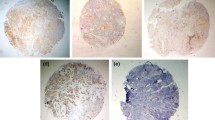Abstract
Epidermal growth factor receptor (EGFR) is a tyrosine kinase receptor of the ErbB family, which is expressed or highly expressed in a variety of solid tumors, including oral cancers. High EGFR expression has been correlated with tumor size, metastasis and survival. In recent years, EGFR has been considered a promising target for monoclonal antibody therapy. A total of 52 patients with oral squamous cell carcinoma (OSCC) were selected for EGFR and phosphorylated EGFR (p-EGFR) detection. Immunohistochemical staining was performed to evaluate EGFR and p-EGFR expression. Positive EGFR and p-EGFR staining was present in 92.3% (48/52) and 98.0% (51/52) of all cases, respectively. High EGFR and p-EGFR expression was present in 63.4% (33/52) and 69.2% (36/52) of all cases, respectively. EGFR and p-EGFR expression did not correlate with the clinical factors tumor stage, regional lymph node metastasis, or distant metastasis. However, a statistically significant correlation was identified between high EGFR expression and the pathologic factor tumor invasion. As a conclusion, the majority of OSCCs highly express EGFR and p-EGFR, indicating the importance of studying the efficacy of anticancer therapy targeting these signal factors.(Pathology Oncology Research Vol 12, No 2, 87–91)
Similar content being viewed by others
References
Salomon DS, Brandt R, Ciardiello F, Normanno N: Epidermal growth factor-related peptides and their receptors in human malignancies. Crit Rev Oncol Hematol 19: 183–232, 1995
Mendelsohn J, Baselga L: Status of epidermal growth factor receptor antagonists in the biology and treatment of cancer. J Clin Oncol 14: 2787–2799, 2003
Irish JC, Bernstein A: Oncogenes in head and neck cancer. Laryngoscope 103: 42–52, 1993
Yamamoto E, Kohama G, Iwai M, Hiratsuka H: Mode of invasion, Bleomycin sensitivity and clinical course in squamous cell carcinoma of the oral cavity. Cancer 51: 2175–2180, 1983
Wada T: Nature of mononuclear cell infiltrates in oral squamous cell carcinoma and their clinical significance. Wakayama Med Rep 30: 103–117, 1989
Putti TC, To KF, Hsu HC, et al: Expression of epidermal growth factor receptor in head and neck cancers correlates with clinical progression: a multicentre immunohistochemical study in the Asia-Pacific region. Histopathology 41: 144–151, 2002
van Oijen MG, Rijksen G, ten Broek FW, Slootweg PJ: Increased expression of epidermal growth factor receptor in normal epithelium adjacent to head and neck carcinomas independent of tobacco and alcohol abuse. Oral Dis 4: 4–8, 1998
Wen QH, Nishimura X, Nagayama I, Furukawa M: Expression of EGF, EGFR and PCNA in laryngeal lesions. J Laryngol Otol 109: 630–636, 1995
Lee CS, Redshaw A, Boag G: Epidermal growth factor immunoreactivity in human laryngeal squamous cell carcinoma. Pathology 29: 251–254, 1997
Kearsley JH, Leonard JH, Walsh MD, Wright GR: A comparison of epidermal growth factor receptor (EGFR) and c-erbB-2 oncogene expression in head and neck squamous cell carcinomas. Pathology 23: 189–194, 1991
Zheng X, Hu L, Chen F, Christensson B: Expression of Ki67 antigen, epidermal growth factor receptor and Epstein-Barr virus-encoded latent membrane protein (LMP1) in nasopharyngeal carcinoma. Eur J Cancer B Oral Oncol 30: 290–295, 1994
Miyaguchi M, Olofsson J, Hellquist HB: Expression of epidermal growth factor receptor in glottic carcinoma and its relation to recurrence after radiotherapy. Clin Otolaryngol 16: 466–469, 1991
Downward J, Parker P, Waterfield MD: Autophosphorylation sites on the epidermal growth factor receptor. Nature 311: 483–485, 1984
Kanematsu T, Yano S, Uehara H, et al: Phosphorylation, but not overexpression, of epidermal growth factor receptor is associated with poor prognosis of non-small cell lung cancer patients. Oncol Res 13: 289–298, 2003
Olayioye MA, Neve RM, Lane HA, Hynes NE: The ErbB signaling network: Receptor heterodimerization in development and cancer. EMBO J 19: 3159–3167, 2000
Kolch W: Meaningful relationships: The regulation of the Ras/Raf/MEK/ ERK pathway by protein interactions. Biochem J 351: 289–305, 2000
Zwick E, Bange J, Ullrich A: Receptor tyrosine kinases as targets for anticancer drugs. Trends Mol Med 8: 17–23, 2002
Busse D, Doughty RS, Ramsey TT, et al: Reversible G1 arrest induced by inhibition of the epidermal growth factor receptor tyrosine kinase requires up-regulation of p27KIP1 independent of MAPK activity. J Biol Chem 275: 6987–6995, 2000
Khazaie K, Schirrmacher V,LichtnerRB: EGF receptor in neoplasia and metastasis. Cancer Metastasis Rev 12: 255–274, 1993
Storkel S, Reichert T, Reiffen KA, Wagner W: EGFR and PCNA expression in oral squamous cell carcinomas-a valuable tool in estimating the patient’s prognosis. Eur J Cancer B Oral Oncol 29: 273–277, 1993
Xia W, Lau YK, Zhang HZ, et al: Combination of EGFR, HER-2/neu, and HER-3 is a stronger predictor for the outcome of oral squamous cell carcinoma than any individual family members. Clin Cancer Res 5: 4164–4174, 1999
Christensen ME: The EGF receptor system in head and neck carcinomas and normal tissues. Immunohistochemical and quantitative studies. Dan Med Bull 45:121–134, 1998
Author information
Authors and Affiliations
Corresponding author
Rights and permissions
About this article
Cite this article
Hiraishi, Y., Wada, T., Nakatani, K. et al. Immunohistochemical expression of EGFR and p-EGFR in oral squamous cell carcinomas. Pathol. Oncol. Res. 12, 87–91 (2006). https://doi.org/10.1007/BF02893450
Received:
Accepted:
Issue Date:
DOI: https://doi.org/10.1007/BF02893450




